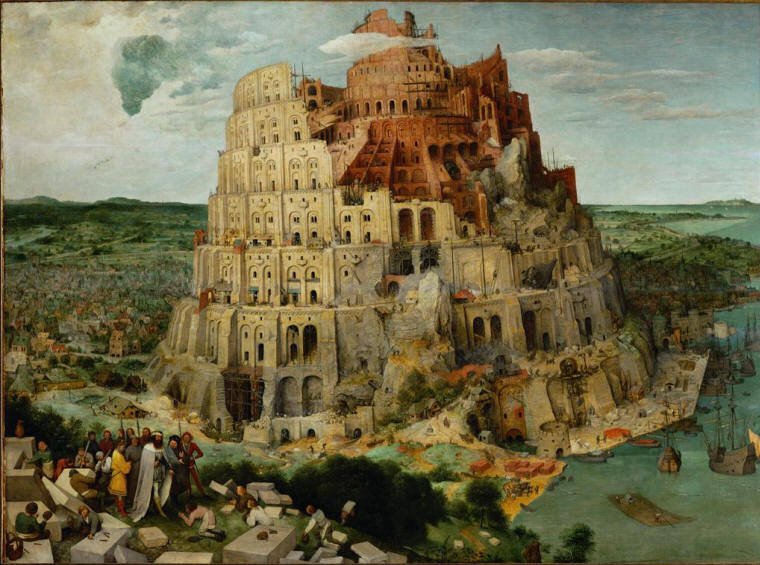
Eric W. Nye, Office Hours: Monday, 12:30 to 2:10 in AIFS Office

Pieter Bruegel the Elder (Flemish, 1525-1569), "Tower of Babel" (1563), Kunsthistorisches Museum, Vienna
Monday, 29 Jan.:
Introduction to the Course. Field Trips to the National
Gallery, British Library, and the British Museum.
Ferguson, "The Reason Why" and "Introduction," pp. 5-9.
Gabel & Wheeler, "To the Reader," pp. vii-x; Ch. 1, "The Bible as
Literature," pp. 1-14.
Abbreviations, etc., Revised English Bible (REB) pp. xxiii-xxvii.
Mary Ann Tolbert, "Reading the Bible," REB pp. *3-*8.
M. Jack Suggs, "Reading This Bible," REB pp. *9-*11.
Paper One assigned, due Monday, 5 Feb. Three pages typed, double spaced. Consider the difference between seeing and reading. Both depend on vision, but what differences are there between a spectator and a reader? Our culture valorizes the visual, the spectacular, the glitzy. But the Bible must be read inwardly, not seen. What kind of reading of the Bible might improve on the more narrowly visual consumption that pervades our culture? What happens in the act of deep reading, in our most intense experiences of reading? If we are becoming a visual culture instead of a literate one, what might be the fate of hard books like the Bible? Or to put it most crassly, what would you say to someone who remarked, "I don't need to read the Bible--I've seen the movie"?
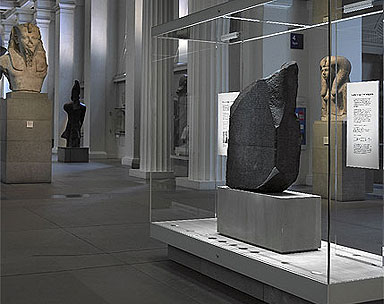
The Rosetta Stone (granite, 196 BC) in the British Museum: the key to Egyptian hieroglyphics
Wednesday, 31 Jan.:
Gabel & Wheeler, Ch. 6, "The Formation of the Canon," pp.
91-105.
James A. Sanders, "Communities and Canon," REB pp. *91-*100 .
Gabel & Wheeler, Ch. 3, "Ancient Near Eastern Literature
and the Bible," pp. 42-60; and Appendix II, "Writing in Biblical Times," pp.
364-72.
Choon-Leong Seow, "Literature of the Ancient Near East," REB pp. *57-*67.
Gabel & Wheeler, Ch. 13, "Apocrypha and Pseudepigrapha:
the Outside Books," pp. 206-223.; and Ch. 16, "The Text of the Bible," pp.
268-81.
Sources and Allusions 1 due: handout.
Monday, 5 Feb.:
Gabel & Wheeler, Ch. 17, "Translating the Bible," pp.
282-305; and Appendix I, "The Name of Israel's God," pp. 359-63.
A Seminar
on the Lindisfarne Gospels at the British Library.
The Gutenberg Bible.
"Editors' Preface" to the REB, pp. xi-xiv.
Donald Coggan, "Preface" to the REB, pp. xv-xvii.
Gabel & Wheeler, Ch. 4, "The Bible and History," pp. 61-72.
W. Lee Humphreys, "Historical Contexts of the Biblical Communities," REB pp.
*33-*47.
David L. Petersen, "The Social World of the Old Testament," REB pp. *68-*78.
Paper One due.

The Chi-Rho monogram from the Lindisfarne Gospels
(c. 700 AD), British Library
Wednesday, 7 Feb.:
Gabel & Wheeler, Ch. 5, "The Physical Setting of the
Bible," pp. 73-90.
Carol Myers, "The Contributions of Archaeology," REB pp. *48-*56.
Leander E. Keck and Gene M. Tucker, "Literary Forms of the Bible," REB pp.
*12-*32.
Gabel & Wheeler, Ch. 2, "Literary Forms and Strategies in
the Bible," pp. 15-41.
Monday, 12 Feb.:
Jonah.
Wednesday, 14 Feb.:
John H. Hayes, "Deity in the Biblical Communities and among Their Neighbors,"
REB pp. *141-*53
Video: Heritage--Civilization and the Jews I.
Gabel & Wheeler, Ch. 7, "The Composition of the
Pentateuch," pp. 106-20.
Richard Elliott Friedman, "Torah and Covenant," REB pp. *154-*63.
"Introduction to the Old Testament," and "The Pentateuch," REB pp. 3-9.
Genesis 1-5.
Monday, 19 Feb.:
Genesis 6-26.
Wednesday, 21 Feb.:
Genesis 27-50.
Review, Midterm Exam Part 1 distributed.
Monday, 26 Feb.:
Midterm Exam, Part 2 (in class).
Midterm Exam, Part 1 (take home essays) due.
Paper Two assigned, due Wednesday, 14 March.

Michelangelo Merisi da Caravaggio (Italian, 1571-1610), "Judith Beheading Holofernes" (1597-98), Galleria Nazionale d'Arte Antica, Rome
Wednesday, 28 Feb.:
Video: Heritage--Civilization and the Jews II.
Monday, 5 March:
Exodus 1-20.
Wednesday, 7 March:
Exodus 32-34, 37
Leviticus 16; Numbers 20-21; Deuteronomy 32-34.
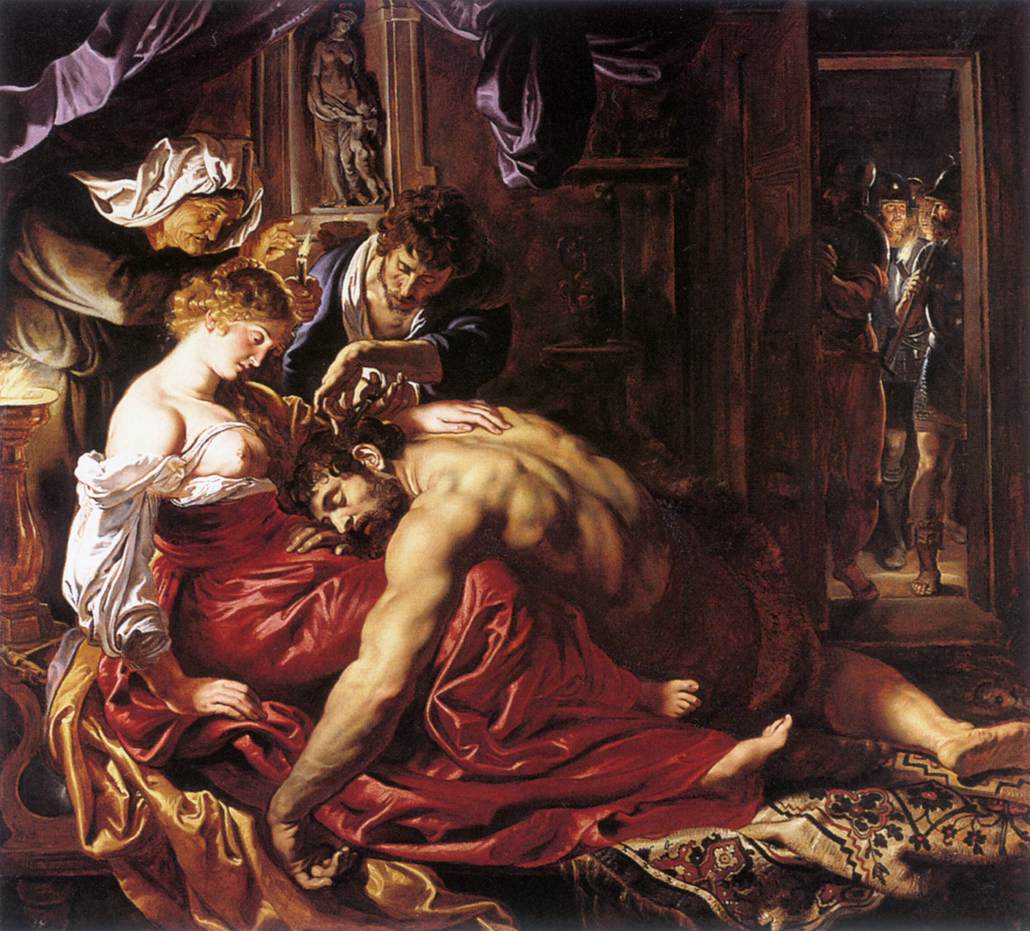
Peter Paul Rubens (Flemish, 1577-1640), "Samson and Delilah"
(1609-10), National Gallery, London
Monday, 12 March:
Joshua 1-6, 23-24.
Judges 1-2, 4-5, 10, 13-16.
Wednesday, 14 March:
Ruth.
1 Samuel 1-3, 8-10, 15-20, 28-31.
Paper Two due.
Monday, 19 March:
2 Samuel 1, 5-7, 11-12, 15-19.
Wednesday, 21 March:
1 Kings 1-19.
2 Kings 1-2; Amos; 2 Kings 16-25.
Monday, 26 March:
Gabel and Wheeler, Ch. 9, "The Wisdom Literature," pp.
134-51.
Dianne Bergant, "The Perspective of Wisdom," REB pp. *172-*80.
Psalms (esp. 1-3, 8-9, 19-23, 30, 37, 41-51, 72-74, 89-90,
96-99, 103-06, 118, 137, 148).
Wednesday, 28 March:
Job.
Proverbs 1-9, 25-31.
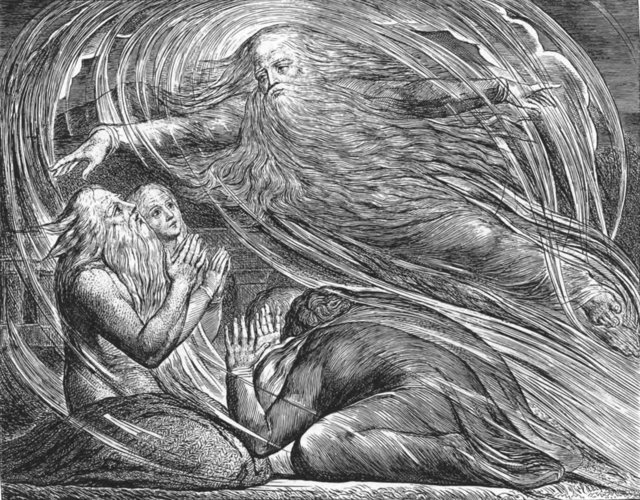
William Blake (English, 1757-1827), "The Lord Speaks to Job out of the Whirlwind, illustration to the Book of Job," engraving on copper plate (1825 ), British Library
Paper Three assigned, due Wednesday, 11 Apr.
Monday, 2 April: No class--Easter Monday
Wednesday, 4 April:
Isaiah 1-13, 36-53.
Gabel and Wheeler, Ch. 8, "The Prophetic Writings," pp. 121-33.
James L. Mays, "The Phenomenon of Prophecy," REB pp. *164-*71.
Monday, 9 April:
Ezekiel. Ezra-Nehemiah, Haggai 1-2, Zechariah.
Gabel and Wheeler, Ch. 11, "Judaism in the Intertestamental Period," pp. 169-88; and App. III, "Palestine in the
Intertestamental Period," pp. 373-80; and Ch. 12, "The Hellenistic Background of
the New Testament," pp. 189-205.
Carol A. Newsom, "The Dead Sea Scrolls and Other Jewish Literature," REB pp.
*101-*11.
Robert Goldenberg, "Hebrew Scriptures in Early Post-Biblical Judaism, with
Special Reference to the Rabbinic Tradition," REB pp. *122-*28.
Wednesday, 11 April:
Gabel and Wheeler, Ch. 10, "The Apocalyptic Literature," pp. 152-68.
Martha Himmelfarb, "The Apocalyptic Vision," REB pp. *181-*89.
Daniel.
Paper Three due.
Monday, 16 April:
Review for Final Exam
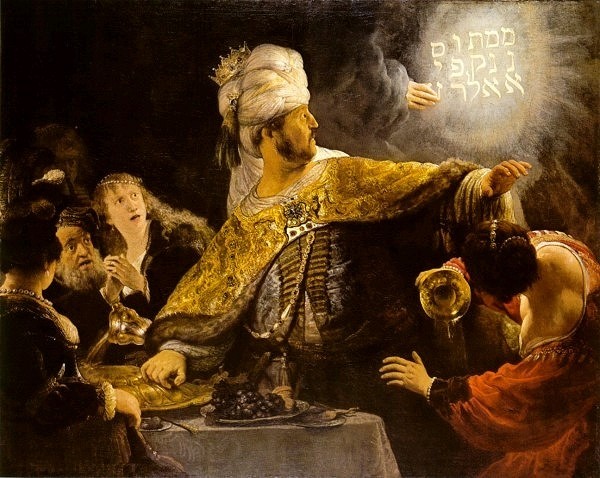
Rembrandt van Rijn (1606�1669), "Belshazzar's
Feast" (ca. 1635-39), National Gallery, London
Final Exam: Wednesday, 18 April
Required books:
Revised English Bible with the Apocrypha (Oxford Study Edition). New York: Oxford Univ. Press (ISBN: 0195290003), paper, 1992. Amazon.co.uk: �19.99 new.
Gabel, John B. and Wheeler, Charles B.. The Bible as Literature: An Introduction. New York: Oxford Univ. Press (ISBN: 0195179072), paper, 5th edn., 2005. Amazon.co.uk: �28.99 new.
Ferguson, George. Signs and Symbols in Christian Art. New York: Oxford Univ. Press (ISBN 0195014324, paper, 1989. Amazon.co.uk: �12.08 new.
Course Pack in PDF form online
Course Description: More properly titled the Bible as Bible, this course deals with the unique status of that document and its profound influence on the forms of our culture. In the first part of the course we learn techniques of literary close reading through a detailed study of the Pentateuch. We explore the history of text and translation, the relation of doctrine and story, narrative style and literary form, the culture and politics of the ancient mideast, the emergence of the Hebrews as a distinct people consolidated by a book, a law--and how these all affect modes of interpretation. In the second part we extend our study into the sacred texts of the later Hebrew and early Christian traditions, and we review briefly the history of biblical hermeneutics, concentrating our attention on the typological and mythological schools of criticism. Several quizzes, take home exercises, three or four essays, a midterm and a final exam and/or paper are required. Cross-listed with Religious Studies 2500. Prerequisite: WA.
Course Objectives:
1. Comprehend the history of the
language, its grammar and syntax, the arts of rhetoric, and the
conventions of expository writing
2. Read extensively in canonical
literature while learning to question the status and historical
formation of the canon: master literary periods, terms, and major
authors
3. Read intensively with formal concentration, discerning the
quality of different literary modes and styles: know the historical
conventions of literary form and be able to differentiate literary
styles
4. Extend these methods of analysis to new works outside the
canon and to works outside the sphere of conventional textuality
5.
Understand various modes of literary criticism and be able to devise
appropriate critical theses both in writing and conversation: know the
major schools of criticism and be able to replicate their interpretative
strategies
6. Show intelligence, imagination, and creativity in the
formation and support of original literary interpretations
7. Relate the
history of literary creativity to allied fields of humane activity:
politics, arts, philosophy, theory and culture in general.
Grading Standards:
Several take home exercises (numerical, total 5% of final grade) Quizzes on assigned readings (numerical, total 10%) Short essays and presentations (letter-grade, total 35%) Midterm exam (half objective-numerical, half essay letter-grade, total 25%) Final exam (half objective-numerical, half essay letter-grade, total 25%) Research paper (optional for extra credit)The final course grade is determined from the weighted total of the above in accordance with usual academic standards (ex: 90-100=A, 80-89=B, etc).
Attendance policy:
University-sponsored absences are cleared through the Office of Student Life. Attendance is essential in a class like this. You will be allowed one absence by prior arrangement for personal business reasons. For that and any subsequent officially authorized absence you will be required to turn in a two-page "absence essay" on the syllabus material for each hour-long class period you miss and must contact me for details. The essay must be turned in the first class period after you return from your absence. Failure to turn in the essay will signify that you do not intend to pass the class. This policy accords with UW Regulation 6-713.
Academic Honesty is strictly enforced according to UW Regulation 6-802 �Procedures and Authorized University Actions in Cases of Student Academic Dishonesty�
Disability Statement: If you have a physical, learning, sensory or psychological disability and require accommodation, please let me know as soon as possible. You will need to register with, and provide documentation of your disability to University Disability Support Services (UDSS) in SEO, room 330 Knight Hall.
Any changes to the syllabus will be announced in class or on this course website, where the date of most recent revision follows:
Last updated Sunday, 10 December 2017